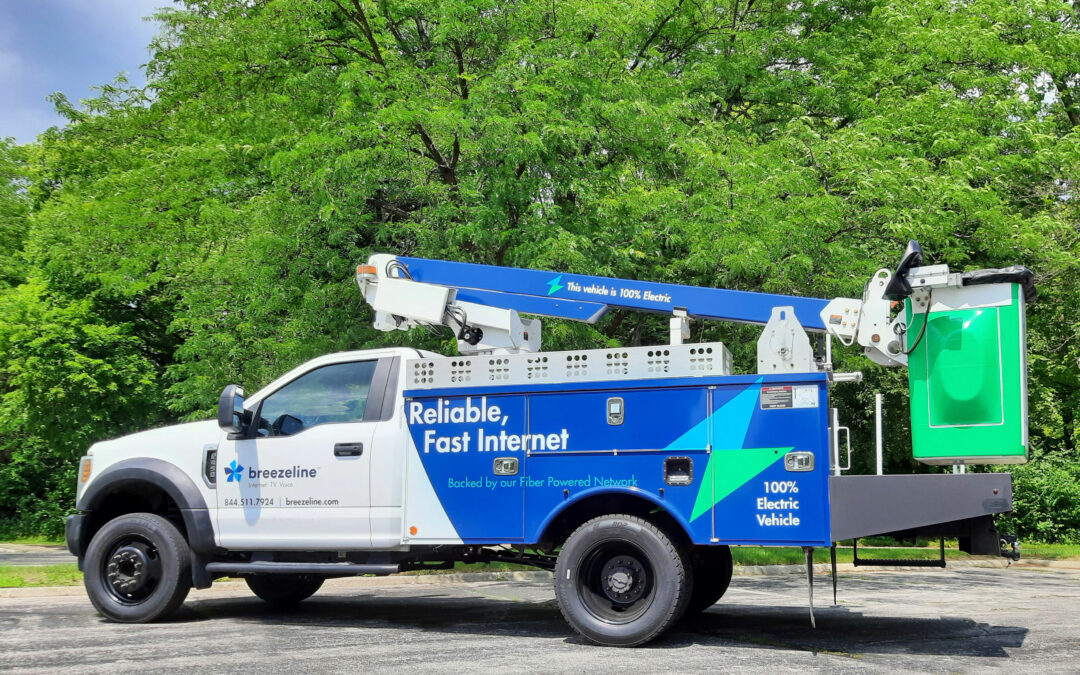If you can’t buy an electric version of your company’s vehicle, maybe you can take the vehicle and retrofit it to become electric.
That’s the route Breezeline has taken in what they say is the first conversion of a bucket truck to electricity, both the motor and aerial boom, ever done by a U.S. cable company. More are on the way.
Electric versions of this vehicle, a Ford F450, are not yet available and there’s a “significant wait” for gas-powered versions, the company said in response to questions from the Monitor. “This solution brings electric-powered technology to our fleet much sooner than if we were to wait until EVs in this class are manufactured new,” spokesman Andrew Walton said.
The company, formerly Atlantic Broadband, operates cable TV and internet services in Concord and a number of other New Hampshire communities. It is the nation’s eighth-largest cable firm. It has a vehicle charging station at its Concord hubsite “and multiple other locations in New Hampshire,” Walton said, and has filed for city permits to “establish renewable energy” at the Concord location.
“This is a major step in our commitment to reduce our operational emissions by 65% by 2030 and achieve net zero emissions by 2050,” said Breezeline President Frank van der Post.
Walton said the move will save money, both immediately and in the long run.
“There is 30% less upfront cost to retrofit an existing vehicle than to replace the vehicle with a new gas-powered vehicle. Ongoing maintenance and operating costs are also less expensive as there is no gas expense, oil changes, etc., and wear and tear is substantially less than in a traditional combustion engine vehicle, including gears and braking systems,” Walton said.
The conversion was done by Zevx, an Arizona company that does such retrofits for commercial fleets around the country.
“Companies come to us for cost reasons or because they have a specialized vehicle and cannot find an electric version. .… But the main draw are companies that have adopted ESG (environmental, social, governance) solutions or goals, or that are being pushed toward EV options” by regulation and legislation, said Jeff Boone, vice president for Zevx.
The usual process, he said, is to remove the engine and drivetrain of a gas-powered truck or van and replace it with an electric motor and batteries. Breezeline is also installing an additional kit that powers the aerial arm and bucket for line work.
“We try to use all the existing (equipment) – brakes, turn signals, monitors – try to connect into that. Sometimes it requires a different radiator or different air conditioning or heater, but usually we can use all of it,” Boone said.
Converting internal-combustion vehicles to electricity has long been a small but thriving industry. Ford, for example, sells an electric version of what is known as a crate motor, a complete engine for people who want to swap out the existing engine in a car or truck. A number of independent firms offer what they call “plug and play” kits for such conversion.
ZEVX is a 3-year-old company with about 120 employees. It does most of its manufacturing at its facility near Phoenix and has installation partners around the country. It converts several models of Ford trucks and vans as well as certain Mercedes and Ram vehicles
New electric versions of any given vehicle cost more than the ICE, or internal-combustion engine, version. Boone couldn’t give cost estimates for the Breezeline work, saying the company is revamping its pricing, but it’s far less than the cost of a new vehicle.
EVs are also heavier, although in this case not by much: Boone said conversions of the F450 usually add about 80 pounds to the total weight.
Lower operating costs are particularly valuable for fleets of vans or trucks that do local or short-haul work and don’t have “range anxiety” about covering long distances between recharging. Merchants Fleet in Manchester, a long-time operator of fleets of commercial vehicles, is buying thousands of electric vans for that reason.
Boone said vehicles of the type that Breezeline bought usually have ranges of 80 to 120 miles on a fully charged battery.


 Return to the Concord Monitor
Return to the Concord Monitor